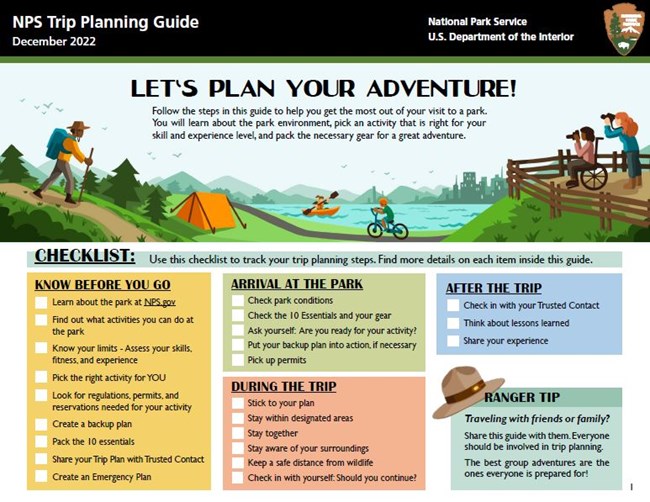Hiking for beginners involves choosing suitable trails and wearing appropriate gear for comfort and safety. Start with easy trails and gradually increase difficulty levels.
Before hitting the trails, ensure you have the necessary gear like supportive footwear and a backpack with essentials like water, snacks, and a first aid kit. Understanding basic hiking etiquette and safety tips is crucial for an enjoyable experience. Proper preparation and research can make your hiking adventures both rewarding and memorable.
Whether you’re aiming for a leisurely stroll or a challenging hike, being prepared and knowing your limits are vital for a successful hiking journey.

Credit: www.nps.gov
Choosing The Right Trail
Hiking is an exciting outdoor activity, especially for beginners. One crucial aspect of a successful hike is selecting the right trail based on your fitness level and the trail difficulty.
Consider Your Fitness Level
Assessing your physical condition is key before embarking on a hike. Choose a trail that matches your fitness level to avoid exhaustion or injuries.
Research Trail Difficulty
Understanding the difficulty of the trail is essential. Check the trail ratings to ensure it aligns with your hiking experience.
Essential Gear And Clothing
When embarking on your first hiking adventure, having the right gear and clothing is crucial for an enjoyable experience in the great outdoors.
Invest In Good Hiking Boots
Hiking boots are your foundation on the trail, providing support and traction. Look for boots that are durable and offer ankle support to prevent injuries.
Dress In Layers For Versatility
Layering is key for hiking comfort. Start with a moisture-wicking base layer followed by an insulating layer for warmth, and top it off with a waterproof outer shell to protect against the elements.
Packing Smartly
When preparing for your first hiking trip, packing smartly can make all the difference between an enjoyable outing and a stressful experience. Here are some essential tips for beginners to ensure you pack efficiently and effectively for your hike:
Carry Enough Water And Snacks
Prioritize carrying enough water for the duration of your hike. Dehydration can quickly set in, especially on warm days or during strenuous climbs. Consider a hydration pack or sturdy water bottles. Additionally, pack lightweight, energy-boosting snacks such as nuts, dried fruit, or granola bars to keep you fueled throughout the journey.
Pack A First-aid Kit
A first-aid kit is a vital part of any hiker’s gear. Include adhesive bandages, antiseptic wipes, blister treatments, and any personal medications. It’s important to be prepared for minor injuries or discomforts that may arise on the trail.
Understanding Trail Etiquette
When embarking on a hiking adventure, it’s not only important to be physically prepared but also to understand and follow trail etiquette. By adhering to proper trail manners, you not only create a positive experience for yourself but also contribute to the preservation of nature and the enjoyment of fellow hikers. In this section, we will discuss some essential trail etiquette practices that every beginner hiker should be aware of.
Stay On Designated Trails
Hiking trails are carefully designed to minimize environmental impact and keep hikers safe. It is crucial that you remain on the designated trails at all times. Straying from the path can damage fragile ecosystems, disturb wildlife, and even put yourself at risk. If you come across any obstacles or closures on the trail, follow any posted signs or instructions provided by park rangers or trail maintenance crews. Remember, staying on the trail keeps you safe and helps preserve the natural beauty of the area for future generations.
Yield To Uphill Hikers
When encountering hikers moving uphill, it is considered good trail etiquette to yield the right of way. Uphill hikers exert more effort and energy to climb, and it can be challenging for them to regain momentum after stopping. As a beginner, it’s important to be mindful of your surroundings and step aside to allow uphill hikers to pass comfortably. This simple act of courtesy shows respect for their efforts and ensures a smooth and enjoyable hiking experience for all.
Safety And Emergency Preparedness
Ensuring safety and emergency preparedness is crucial when it comes to hiking, especially for beginners. As you set out to explore the beautiful trails and immerse yourself in nature, it’s essential to plan for any potential risks and be equipped to handle emergencies. In this section, we’ll discuss two important aspects of hiking safety: planning for changing weather conditions and sharing your hiking plans.
Plan For Changing Weather Conditions
Weather conditions can be unpredictable while hiking, and it’s essential to be prepared for any sudden changes. Here’s how you can plan accordingly:
- Check the weather forecast: Before heading out, always check the latest weather forecast for the hiking area. This will help you anticipate any potential rain, storms, or extreme temperatures.
- Dress appropriately: Wear layers of clothing that can be easily adjusted as the weather changes. Opt for moisture-wicking and quick-drying materials to stay comfortable, and bring a waterproof jacket or poncho to protect yourself from rain.
- Cover your head and apply sunscreen: Protect your skin from the sun’s harmful rays by wearing a hat or a cap and applying sunscreen with a high SPF. This is important, even on cloudy days when UV rays can still penetrate through.
- Stay hydrated: Proper hydration is vital, regardless of the weather. Carry enough water and drink regularly to prevent dehydration. Even in cooler temperatures, the body still loses moisture through sweat and respiration.
- Be aware of hypothermia and heat exhaustion: Learn the signs and symptoms of both hypothermia and heat exhaustion. If you notice any symptoms such as shivering, dizziness, confusion, or excessive sweating, take immediate action to treat and prevent further complications.
- Know when to turn back: If the weather becomes severe or you feel unsafe, trust your instincts and consider turning back. It’s better to postpone your hike or choose an alternative route than to put yourself in unnecessary danger.
Share Your Hiking Plans
Letting others know about your hiking plans is an important safety measure. By sharing your itinerary, you enable others to keep track of your whereabouts and raise the alarm in case of an emergency. Here’s how you can do it:
- Inform a trusted contact: Before heading out, inform a family member or a friend about your hiking plans. Share details such as the trail you’ll be taking, estimated start and end times, and any planned stops or campsites along the way.
- Use technology: Take advantage of modern technology by using hiking apps or GPS devices to track your location. Some of these tools allow you to share your real-time location with others, providing an extra layer of safety.
- Set a check-in schedule: Decide on regular check-in times with your designated contact. This will create a routine for communication and ensure that someone is aware of your progress during the hike.
- Stick to the plan: Once you’ve shared your hiking plans, try to adhere to them as closely as possible. If changes are necessary, make sure to update your contact to avoid any unnecessary concern or confusion.
- Check-in after your hike: Lastly, remember to check in and let your contact know that you’ve completed your hiking trip safely. This will provide peace of mind to your loved ones and allow them to close the loop on your hiking adventure.
By planning for changing weather conditions and sharing your hiking plans, you can enhance your safety while enjoying the wonders of hiking. Remember, preparation is key, and taking these precautions will help make your hiking experience both enjoyable and worry-free.

Credit: koa.com

Credit: www.hipcamp.com
Frequently Asked Questions For Hiking For Beginners
What Are The Essential Hiking Gears For Beginners?
For beginners, essential hiking gears include a sturdy backpack, comfortable hiking shoes, water bottle, proper clothing layers, navigation tools like a compass or GPS, a first aid kit, and a reliable headlamp.
How Should Beginners Choose A Hiking Trail?
Beginners should choose a hiking trail that matches their fitness level and experience. Look for trails with lower difficulty ratings, shorter distances, and clear trail markers. Start with well-maintained trails in local parks or nature reserves to build confidence and assess personal hiking capabilities.
What Safety Precautions Should Beginners Take While Hiking?
Safety precautions for beginners include informing others about the planned hike, checking weather conditions, carrying extra water and snacks, wearing appropriate clothing and footwear, staying on marked trails, practicing proper hiking etiquette, and being aware of potential wildlife encounters. Always plan and prepare for emergencies.
Conclusion
Hiking for beginners is an exhilarating and rewarding experience. With the right preparation and knowledge, anyone can embark on this journey. The mental and physical benefits of hiking are undeniable. So lace up your boots, hit the trails, and explore the wonders of nature.
Happy hiking!